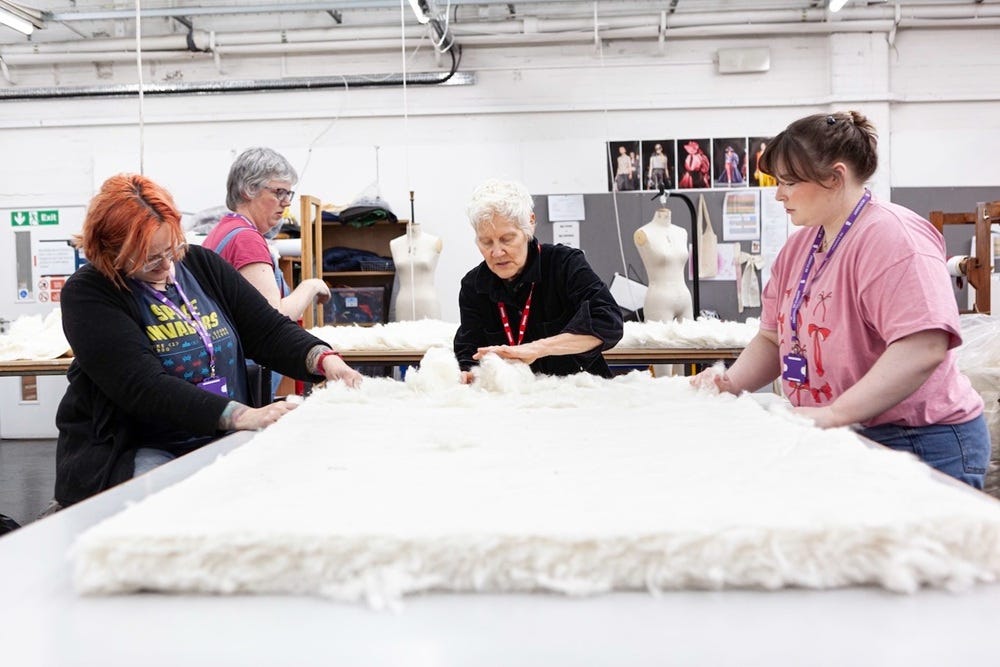Sing a song of a textile city
Bradford celebrates its status as UK City of Culture 2025 with art installation evoking its rich industrial heritage
THERE was a time when the city of Bradford, in West Yorkshire, was the wool capital of the world. These days you'd be forgiven for thinking there's precious little left of the industry that shaped its fortunes and its presence.
A few derelict – or converted old mills – remain, of course. The gargantuan Manningham Mills' grand Italianate chimney still rises high above the skyline (although it handled silk, not wool); parts of the mill complex itself given over to luxury apartments these days.
Then there's the old warehouse district known as Little Germany, which retains much of its former glory, if not its original purpose. Mention must also go to the Wool Exchange in the city centre. Once, the beating heart of the global wool trade, it's trading floor is now a Waterstones bookshop; a fine way to keep this widely regarded architectural gem alive and well.
Venture further afield to the outlying areas of the city, to Shipley, and there's the Salts Mill complex; now home to an art gallery, and of course the UNESCO World Heritage accoladed Saltaire; a model village established by local 19th Century wool baron, Sir Titus Salt to house his industrial workers.
As for the industry itself, from its heyday in the early-to-mid 20th Century when there were around 350 or so mills in operation, less than 30 remain active today. Even so, the rich heritage it has left behind remains strong; raw material for contemporary cultural excursions drawing on the past, to look at the way ahead.
City of Culture 2025
A TransAtlantic artistic collaboration is currently exploring that rich industrial heritage, as the city celebrates its year in the limelight as the City of Culture 2025.
A group of higher education students at the Bradford School of Art were chosen to work with the internationally acclaimed American artist, Ann Hamilton. The art installation they worked on draws upon the legacy of the textile industry, and it represents the visual artist's first UK show in over 25 years – not to mention, her largest.
We Will Sing is a new, large-scale, site-responsive installation, commissioned for Salts Mill as part of the city's City of Culture celebrations. The project is inspired by the history and regeneration of Salts Mill, as well as the district’s textile heritage.
The art draws on the origins of the textile processes that once filled the huge space. Working with artefacts from the mill, Hamilton’s installation brings together song, printed word, cloth, raw and woven wool.
The textiles are sourced from local companies in Bradford, including H Dawson, founded in 1888 and now based at Salts Mill, and William Halstead, which this year celebrates its 150th anniversary.
As part of the project, 16 students enrolled on either the Bradford School of Art Foundation Degree (FdA) in Textiles Practice, or the BA Textiles Practice degree experienced working as fabrication assistants. Over three weeks, they constructed large-scale textile elements for the installation and worked directly with Hamilton and her studio.
“Being involved in this project has been a profoundly rewarding and inspirational experience,” said Hannah Lamb, Bradford School of Art's programme leader (BA/FdA Textiles Practice). “For several weeks in April, we played host to Ann Hamilton and her studio team at Bradford School of Art. A group of our students assisted with the making of huge wool panels, which now form part of Ann’s immense installation work at Salts Mill.
“Bradford 2025 has described this project as one of their stand-out projects for UK City of Culture, so this was an incredible opportunity for our higher education students. The opportunity for us to work alongside an artist of this calibre has been a dream come true, and will continue to inspire us for years to come.”
The first stages of fabrication took place at Bradford College in specialist textile workshops and performance spaces, before being carefully relocated to the vast top floor of Salts Mill, where students continued to work on the project in situ.
Transformation place
Described by Hamilton as a work of memory and imagining, the installation features immersive, site-specific soundscapes. These were developed in collaboration with vocalist and world champion whistler Emily Eagen from recordings made on site, and in workshops with local schools and community groups.
Hamilton is acclaimed for her large-scale multimedia installations, public projects, and performance collaborations. She has created major commissions for institutions around the world, including Park Avenue Armory, and The Museum of Modern Art, New York.
“We Will Sing began the moment I first opened Salts Mill’s large wooden doors,” Hamilton said. “I immediately sensed this as a place of transformation committed not just to its architecture but to the future of a community, and to imagination’s transformative power.
“I hope my project is a small part of envisioning this possibility. It has been an honour to work with the community, to find openness and generosity, and, like all touch, to be touched in return. This exchange, this sharing, is the heart of We Will Sing.”
MC




